Synology DS423+ vs DS923+ NAS – Which Should You Buy
Buying your first network-attached storage device can be really intimidating! If you have spent the better part of a decade storing your personal or business data on public cloud services or in a drawer full of USB drives, but have now taken the grown-up decision to go ahead and migrate over to your own private network-attached storage (NAS). You might have done this for reasons of cost, centralization or perhaps for security, whatever the reason for your data migration, there is simply no denying that the world of NAS can be a fraction complex and confusing early doors. Like any kind of modern computer appliance, you want to make sure you buy right the first time and when it comes to choosing between two of the latest generations of Synology NAS devices, these two incredibly similar four-bay devices might be two of the most different solutions I have ever compared. The Synology DS423+ is a home and small business-focused compact NAS designed to leverage an affordable price point between reasonable hardware and reasonable software and abilities. The slightly older Synology DS923+ (by 6+ months), on the other hand, has much of a high and even in some places entry enterprise-level focus about its architecture and is needless to say the more expensive of the two. Nevertheless, both of these Synology NAS devices can be picked up for around $450 to $600 (without drives), the contrast between their pricing, are actually very different beasts. Therefore, for users that don’t quite know their AMD embedded from their Celeron integrated processors, or who aren’t sure of the benefits that ECC can bring, today I want to compare the Synology DS423+ and Synology DS923+ and help you decide which one best deserves your data!
![]()
Just before we get into the meat and potatoes of this comparison, it is worth highlighting that regardless of whether you buy the Synology DS923+ or DS423+, you are guaranteed to get a system that can perform all of the following:
- Both units feature x86 processors, which allow a wide degree of app/services to run well and are a good price vs hardware balance
- Both the DS923+ and DS423+ are constructed of plastic desktop compact chassis, thereby reducing power consumption, noise and heat generated
- Both can Stream 1080p HD or 4K media, with superior performance natively and mid-range performance in Plex
- Both the Synology DS923+ and DS423+ NAS support AI-supported photo and ‘thing’ recognition supported to a very high degree from the free branded software included
- For Business users who currently enjoy the use of Google Workspace or Office 365, both of these NAS provide excellent means to backup your mass cloud accounts (as well as natively sync, dupe and configure rules on the fly)
- Both the DS423+ NAS and DS923+ NAS support snapshots, for more incremental and version protecting failsafe in efforts to protect you from Malware and Ransomware attacks, by allowing multi-versioning storage history to browse through and restore
- Both units are DLNA certified so can be accessed, browsed and played from by popular DLNA devices, such as Amazon Firestick, Alexa, Google Home Chromecast, Apple TV, Bose, Sonos, iPads, etc, as well as connectivity between these platforms with IFTTT
- Both are multi-bay, RAID enabled devices NAS devices that support JBOD, RAID 0, RAID 1, RAID 5, RAID 6 and RAID 10 (as well as Synology Hybrid RAID too for their Plus series range), though it is worth highlighting the DS923+ is the only one that supports an expansion and therefore also can support RAID 5, RAID 6, RAID 10 and SHR-2 over an expansion (more on that later)
- Both devices run on their own proprietary operating system that can be accessed remotely or locally. These include regular updates to the firmware, security patches, applications and more. Ranging from multimedia, home and multi-tiered backup applications, to more business end tools such as Surveillance software, Virtual Machine deployment and business-class backup and synchronization tools.
- Both the DS423+ and DS923+ use and can be accessed equally by a multitude of mobile applications such as DS File, DS Video, DS Photo, DSCam and DS Music that are created by and constantly improved by Synology.
- Both NAS are completely compatible with Windows, Android and Mac systems, as well as acting as a bring between software platforms to share and distribute files for migration and file sync]
- Both units can be used as a mail and/or business servers, providing excellent 3rd party CRM and first-party CMS systems, as well as the fantastic Synology collaboration Suite of applications Chat, Drive, Mail, Calendar, Office and Active Backup Suite
- Both systems will support DSM 7.1 or DSM 7.2 out the box, as well as support software updates (security and feature) for many years moving forward
- Both systems support the Synology Surveillance Station applications, support numerous cameras and arrive with 2 camera licenses with your purchase
But you didn’t come to this comparison page to find out what they had in common, you wanted to know what makes them different and which one best suits your needs, so let’s crack on with this comparison.
Synology DS423+ vs DS923+ NAS – Price and Value
Now, for those of you that are keeping a very close eye on the budget, it will already be clear to you that the Synology DS423+ is the lower-priced NAS of the two, by quite a considerable margin! Arriving, depending on where you are in the world, for around $449 to $499, it will immediately look more appealing to those on a tight budget when compared against the $549 to $599 of the DS923+. And that is before you’ve gone ahead and purchased any storage media too, so that’s saving of $100 to $150 could go a long way to further bolstering your network-attached storage setup. So, if the most important thing to you right now is remaining within a tight budget, then it might be worth seeing to read the rest of this article as when comparing DS423+ and DS923+, we have to look considerably more at the subject of value, not price. Price. Both of these devices arrive with the same software, Synology DSM 7.2, as well as both systems being two drive NAS solutions that support nearly identical ranges of storage media too, but more on that later. In terms of physical size, the range of components, they are pretty darn similar at a casual glance. However, it is in terms of the individual hardware components and scalability where the Synology DS923+ shows its worth, which we will cover shortly in the hardware section. But at least in terms of numerical value, the Synology DS423+ carries the lead. However, the reality isn’t quite that simple:
This is because the Synology DS923+ was released approx than half a year earlier than the DS423+ (Nov 2022 vs April 2023) and because of its wider availability and longer presence in the market, it has been featured in numerous special offers throughout that time. We saw this near $500 NAS on a few considerably impressive special offers throughout Amazon Prime day and other smaller eShop-specific events. So, yes, the DS423+ is the lower-priced NAS of the two, but do make a point of checking your local online retailer to see if the DS923+ is on special offer right now!
Synology DS423+ vs DS923+ NAS – Hardware and Connections
The hardware architecture of the DS423+ and DS923+ clearly have two very different target audiences in mind. The DS423+ has more of a home and multimedia feel about it, while the DS923+ feels substantially more like a business solution. This is reflected in numerous areas such as the distinct differences in CPU, memory specifications, and potential for growth. Even if you were to take into account the affordability of the DS423+, it has to be said that in the majority of hardware available, the DS923+ is significantly more powerful and scalable in practically every way. Here is a brief summary of the key hardware highlights of either system, side-by-side:
| Synology DS423+ vs DS923+ NAS Hardware Comparison | ||
| Synology NAS | 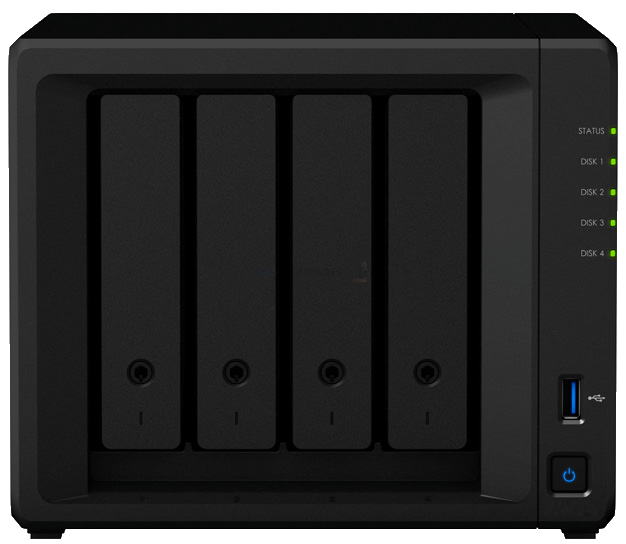 |
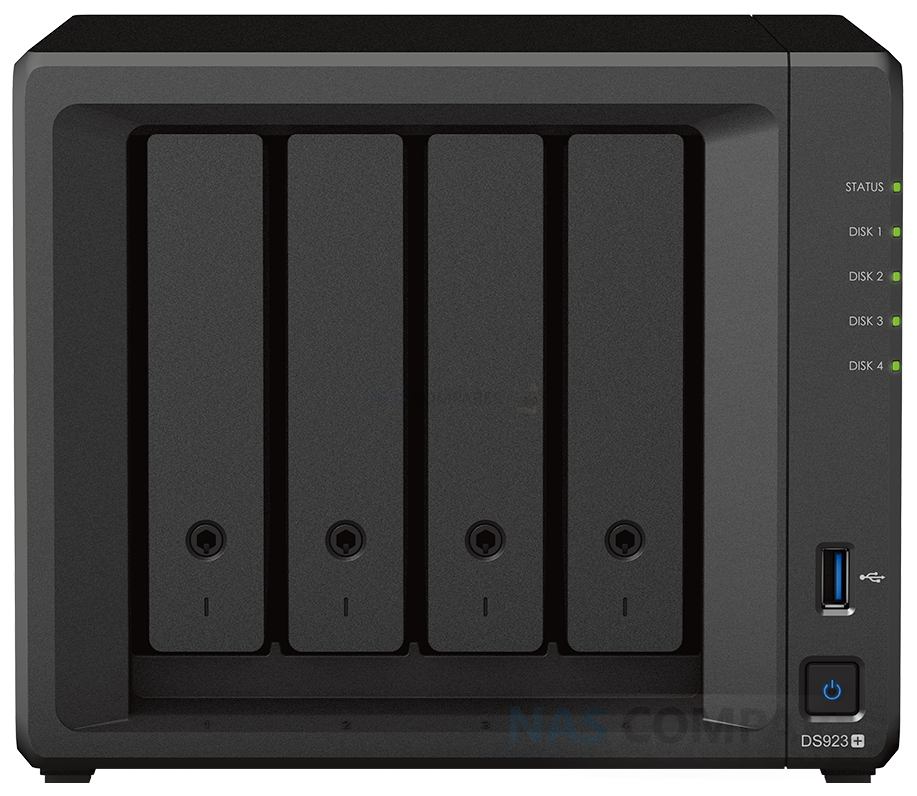 |
| Amazon Price: | $479 (Amazon 25/02/24) | $599 (Amazon 25/02/24) |
| Processor model | Intel Celeron J4125 (2019 Gen) | AMD Ryzen R1600 (2020 Gen) |
| processor architecture | 64-bit | 64-bit |
| processor clock | 4-core 2.0 (base frequency) / 2.7 (burst frequency) GHz | 2-core 2.6 (base frequency) / 3.1 (max overclock) GHz |
| Integrated Graphics | Yes (250-750Mhz) | No |
| Hardware encryption engine (AES-NI) | Yes | Yes |
| system memory | 2 GB DDR4 non-ECC | 4 GB DDR4 ECC |
| Pre-installed memory modules | Yes | 4GB (4GB x 1) via SODIMM |
| Total number of memory slots | 1 | 2 |
| Maximum memory capacity | 6 GB (2 GB + 4 GB) | 32GB (16GB x 2) |
| The maximum number of disk slots for an expansion unit | N/A | 7 (DX517 x 1) |
| M.2 drive bay | N/A | 2 (NVMe, PCIe 3×1) |
| Compatible Disk Type |
|
|
| Disk hot-plug support* | Yes | Yes |
So first and foremost, we need to discuss the main differences between the CPUs available here. The Intel Celeron found inside the DS423+ is a four-core, four-thread processor with a clock speed of 2.0 GHz that can be burst to 2.7 GHz when needed. However, despite the age of this CPU, which was released towards the end of 2019, it is the integrated graphics of this processor that gives it a slight edge for some users in terms of NAS deployment- especially those looking at multimedia use for their system. For users that are looking at the manipulation of graphical data, or more commonly are using the NAS as a multimedia server and wish to convert dense multimedia into something more manageable locally (for example, converting a dense 4K file into a much smaller and portable version to watch on the phone whilst commuting to work, on the fly), integrated graphics allow the NAS to perform this task with much lower overall resource consumption.
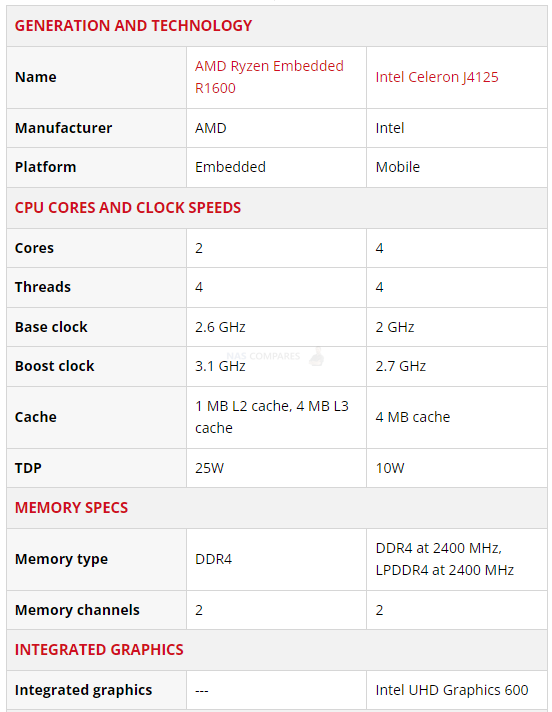
Thanks to it having a more specialized tool to get this job done. The embedded Ryzen R1600 processor on the other hand, lacks the integrated graphics and is a dual-core processor instead of a quad-core. However, it substantially makes up for this by being a much more powerful dual-core processor, with four threads that allow the system to assign system resources in a similar way to that of having multiple cores. Equally, the clock speed is noticeably higher here with the DS923+ CPU having a 2.6 GHz base power that can be burst when needed to 3.1 GHz. It is true that in cases of graphical manipulation or multimedia conversion, the AMD CPU here will be far less efficient and capable. However, in practically every other way, it is superior to that of the J4125 inside the DS423+. And if you are more concerned with traditional file transfer speeds internally and externally, the DS923+ will comfortably be the better-performing NAS.
The CPU choices in the DS423+ and DS923+ also result in very different memory architectures in each device, which will undoubtedly result in different scalability in the long term. The DS423+ arrives with 2GB of 2666Mhz memory, soldered to the main controller board, which can be further expanded via an available SODIMM memory slot to 6 GB total. This may be a little disheartening when you find out that the CPU here is actually capable of supporting 8 GB maximum memory. However, due to that initial 2GB memory being fixed internally, you cannot officially exceed 6 GB physically. This shortfall is considerably magnified when you bring into comparison the DS723’s memory structure. It arrives with 4GB of DDR4 3200Mhz memory which can be expanded to a whopping 32 GB total across two available SODIMM slots. Additionally, the system arrives with error-correcting code (ECC) memory, which ensures that data that passes through the memory during write operations will have its integrity checked by a separate module on the memory of the system. If any irregularities or inconsistencies are spotted, that data will be repaired. This goes a long way to reassure any doubts around the integrity of long-term archival data and susceptibility to things like bit rot. This is one of the main reasons why the DS923+ is considered much more of a business solution overall.
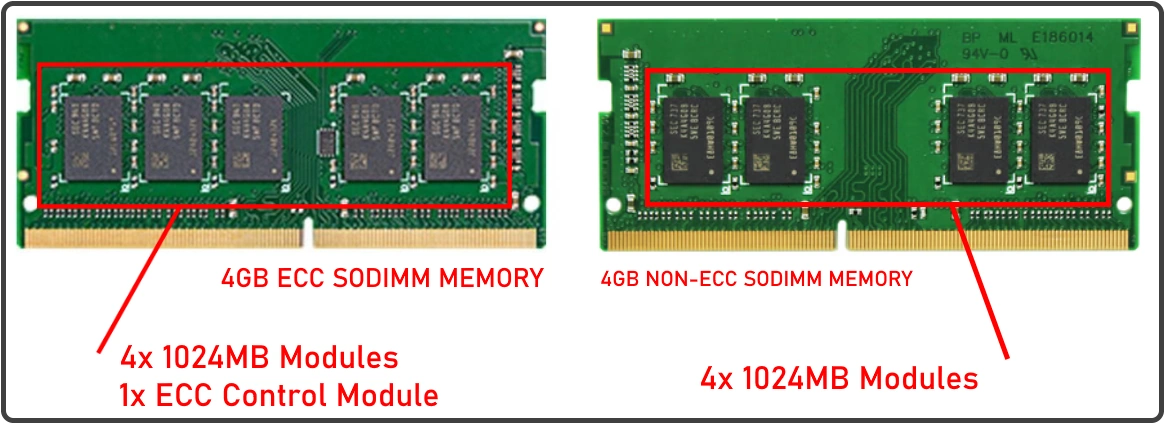
Much like the memory choices by Synology in these two NAS devices, the ports and connections of them both are similar, but one is definitely more scalable than the other. Both systems arrive with standard gigabit ethernet connectivity, with two available ports that each will provide up to a maximum 109 megabytes per second. Both systems also arrive with USB 3 connectivity, but it is only 5GB gen 1 USB. However, it is from here onward that the DS723 massively upscales things:
| Model ID | Synology DS423+ | Synology DS923+ |
| Synology NAS | 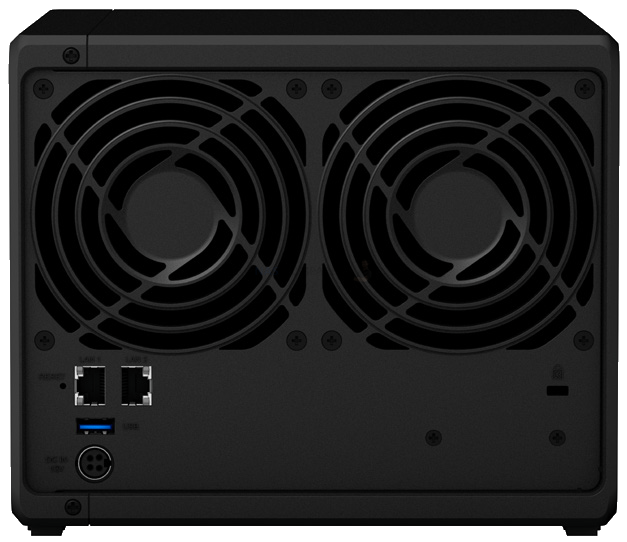 |
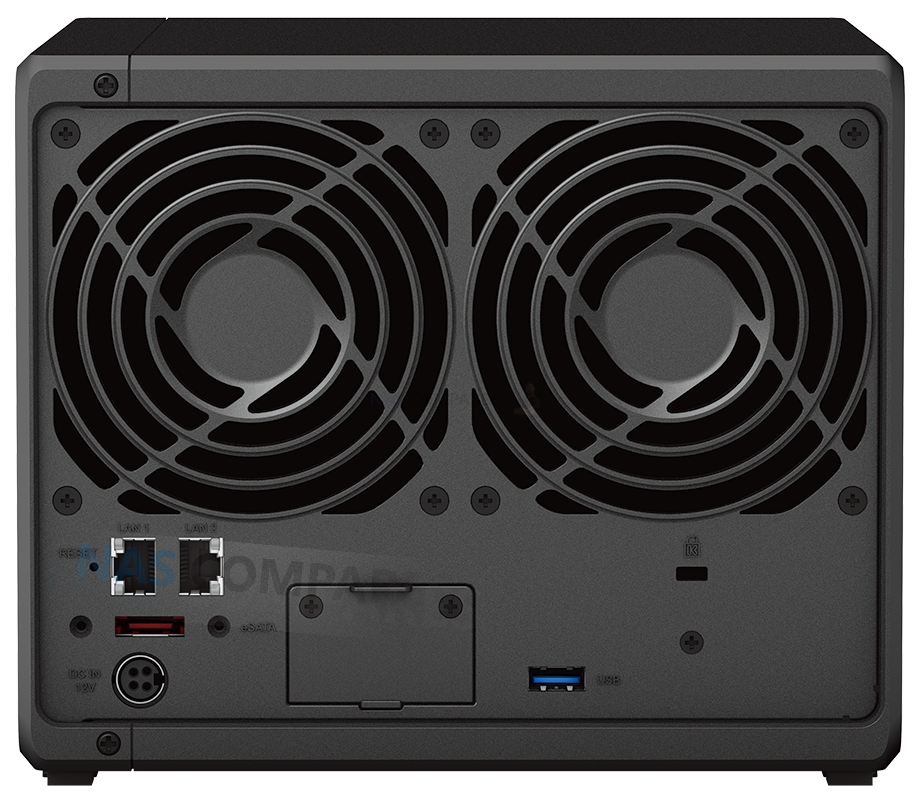 |
| RJ-45 1GbE LAN port* | 2 (Supports Link Aggregation / Failover) | 2 (Supports Link Aggregation / Failover) |
| USB 3.2 Gen 1 port* | 2 | 2 |
| eSATA port | 0 | 1 |
| USB Copy | Yes (inc. Physical Button) | Yes |
| PCIe expansion | N/A | 1 x Gen3 x2 LAN card slot |
| system fan | 92 mm x 92 mm x 2 pcs | 92 mm x 92 mm x 2 pcs |
| fan mode |
|
|
| Front panel LED indicators with adjustable brightness | Yes | Yes |
| Noise value* | 19.8dB(A) | 22.9 dB(A) |
| wake on lan | Yes | Yes |
| Power Supply / Transformer | 90W | 100W |
| AC input voltage | 100V to 240V AC | 100V to 240V AC |
| current frequency | 50/60 Hz, single frequency | 50/60 Hz, single frequency |
| Power consumption | 28.3 W (access) 8.45 W (disk hibernation) |
35.51 W (access) 11.52 W (disk hibernation) |
For a start, the DS923+ features an eSATA external port that is used to connect the official Synology 5-bay expansion device, the DX517. This means that while the DS423+ has a maximum long-term capacity of four SATA drives, the DS923+ allows you to expand your storage down the line by an additional five SATA bays (so 9 Bays total). This can be done gradually and this storage can either mirror the original NAS or extend the storage pool across both devices.
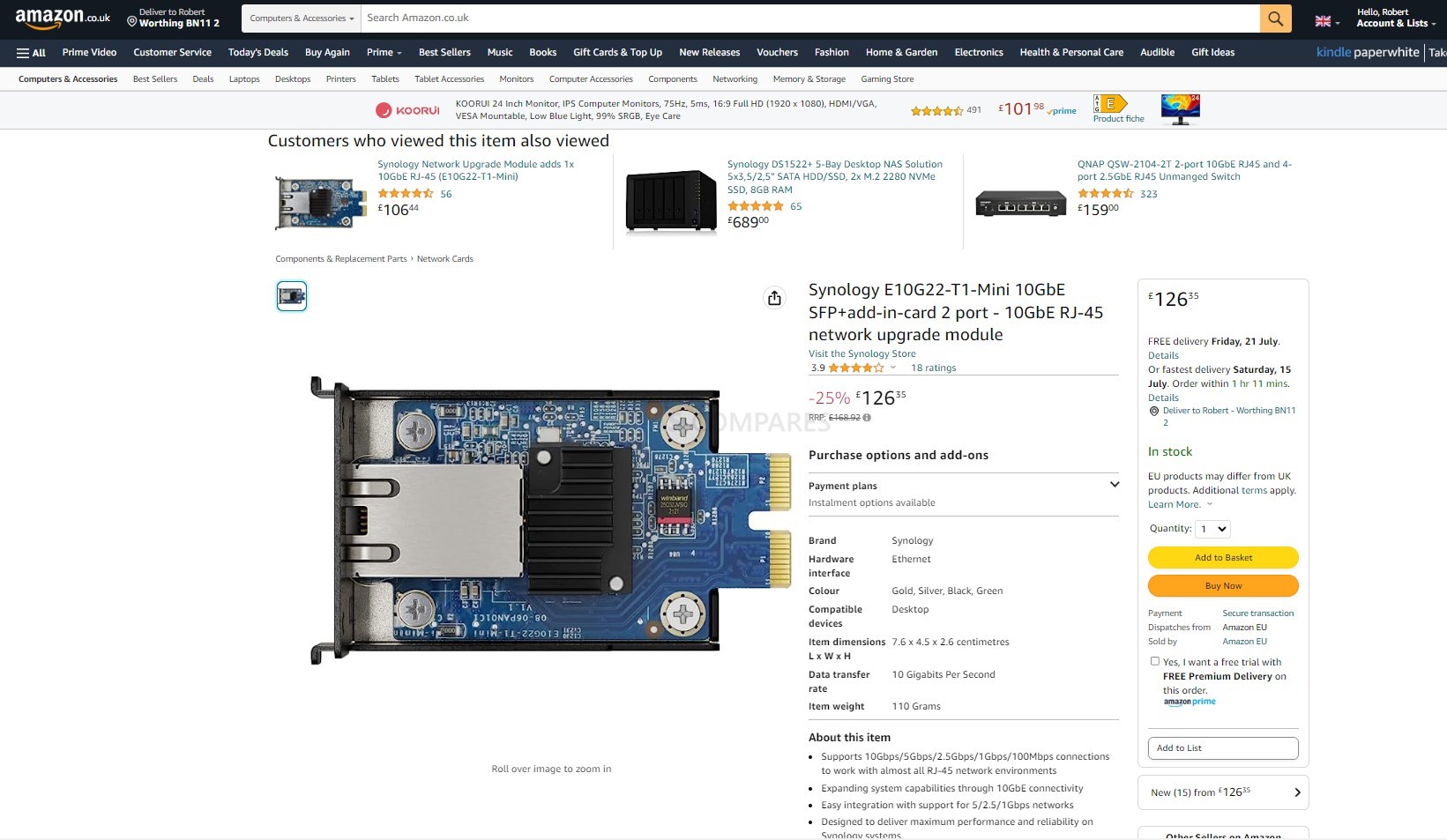
Scalability and expandability do not stop there though, with the DS923+ also having the option to add a network adapter upgrade module (the E10G22-T1-MINI) to increase your network bandwidth to 10GbE. This is going to be incredibly useful for users who plan on taking advantage of SSDs or plan on having a much busier network environment between the NAS and multiple users and tasks at any given time. And it doesn’t stop there! Though BOTH systems also features two SSD bays on its base for installing M.2 2280 SSD modules (which can be used for caching or as raw storage pools, depending on which drive you use), the DS423+ is a Gen 2 PCIe lane system, whilst the DS923+ is a Gen 3 system – resulting in double the bandwidth per lane (ultimately, the difference between 500MB/s max per SSD on the DS423+ and 1,000MB/s on the DS923+). This is a feature that, although growing more common across Synology’s NAS portfolio, it is still unavailable on many of their lower tier/affordable systems (such as the DS224+) and, alongside the lack of storage expansion support, the gen2 speeds on these bays will place limits the storage potential long term on the more affordable NAS.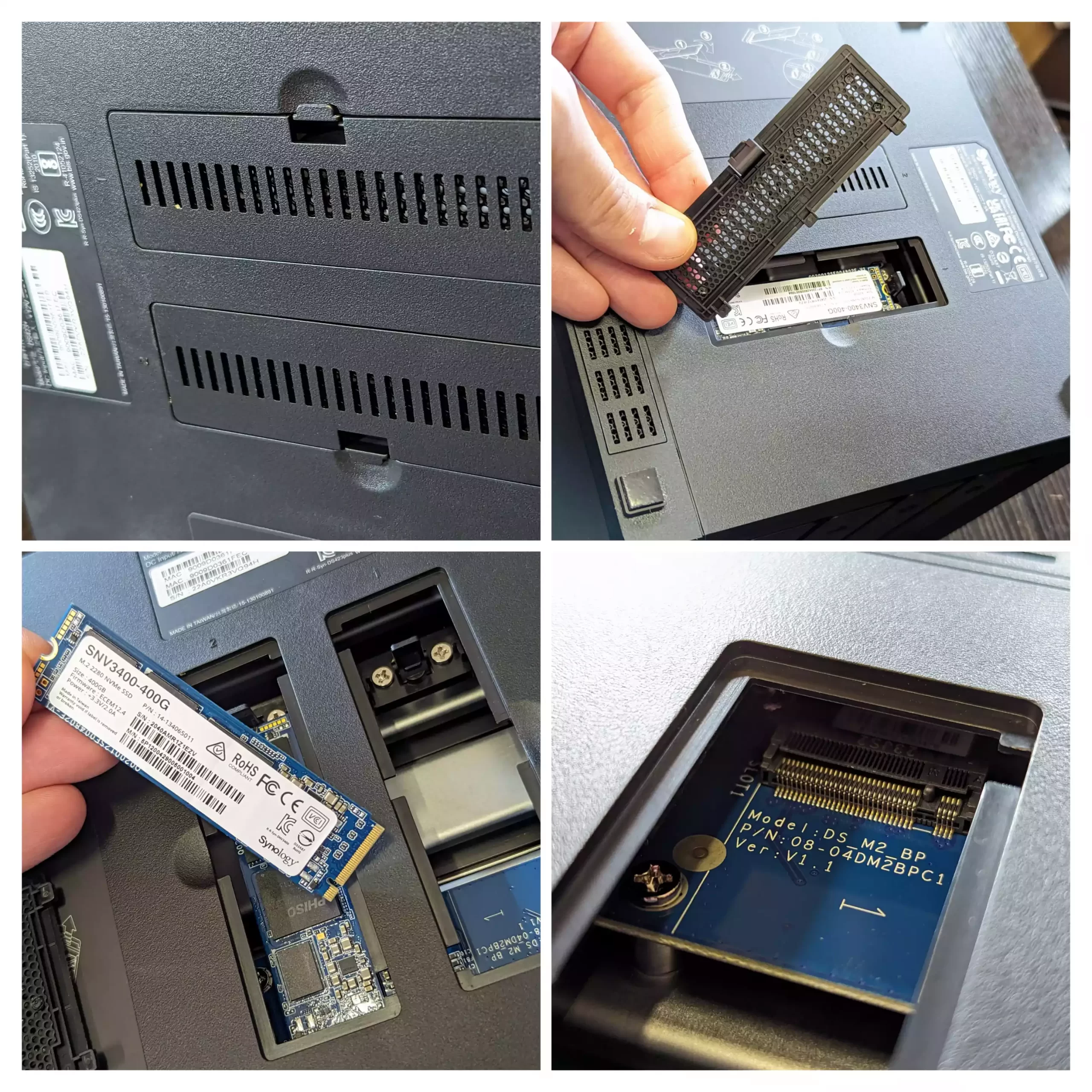
Finally, we need to discuss storage media compatibility, as this has grown to be another thing that has changed the way in which a user can populate their NAS quite a lot in recent years. On the list of storage media that they are prepared to verify as compatible with their systems. Although technically, one could say that any SATA media drive would be compatible with a SATA NAS, there are still a few incredibly isolated examples of compatibility, durability and stability. Synology requires that all drives need to be officially checked and verified before they’re prepared to add them to their list in order to truly guarantee that a user will get the promised Synology experience from their hardware with that media. As questionable as this might sound, the result is that the list of compatible storage media for both of these devices, despite their incredible similarities, is actually pretty darn different. Take a closer look at the slideshow below of compatible HDDs from WD and Seagate on these two NAS systems (from 21st July 2023) and see if you can spot an odd inconsistency:
In the case of the DS423+, we see a smaller pool of supported storage media, as well as a lower list of larger capacity drives being featured also. The DS923+, on the other hand, seemingly has a larger pool of more high capacity drives added and available to it, as well as a larger range of Synology’s own drives available for use with that system that includes the higher end options in the HAT5300 range. Synology has clearly prioritized higher-end drives for more advanced Synology systems, but for those that like to use their system clearly and rigidly within the defined parameters of a brand to maintain their warranty/guarantee, this is going to be a little disheartening to see the smaller pool of verified compatible storage media on the more affordable NAS solution. This is something that may well change over time as more drives are added to verified compatibility lists, but Synology has not exactly been putting their foot on the gas here. Given how close these two systems have been released side by side and the large disparity between their compatibility lists, I can’t see a huge amount of change happening anytime soon. It is absolutely no surprise that the more expensive Synology NAS has a better degree of hardware options in the long term. Though, it should be highlighted that a lot of the real benefits available in the DS723 are optional extras, long-term scalability and upgrades that are not necessarily available in the default model. It could be very easily argued that you are paying for entry to then pay extra for delivering upgrades, SSD upgrades, storage scalability, and increasing your memory years from now. Nevertheless, the fact that the baseline memory is ECC and the AMD CPU is indeed more powerful in most ways, does make up some of that additional cost and ultimately mean that in terms of hardware and connectivity, the DS923+ is the better of the two.
Synology DS423+ vs DS923+ NAS – Software and Services
At the risk of being incredibly repetitious, both of these devices are remarkably similar in what they can do in Synology’s premium DSM software platform, but the scalability and scope provided by the DS923+ inevitably leads to that more expensive system, ultimately giving you just more resources with which DSM can utilize. In terms of the actual range of applications, services supported on either system and scope for use right out of the box, both the DS423+ and DS923+ have got more than enough to run every single available app and tool available in DSM 7.2. Despite their rather modest scale, both systems can run multiple virtual machines, host a fantastically capable surveillance solution with numerous cameras, both can provide an excellent Plex media server experience (with a slight edge to the DS423+ in terms of conversions and transcoding when needed), and in terms of backups, both systems support the full range of services from Hyper Backup and Active Backup Suite. If you are a small business or just a small group of users who are going to be interacting with either of these NAS units fairly regularly, you’re going to have a largely identical experience in either one of these two systems using the baseline default hardware. However, things will change as soon as you start moving into larger simultaneous access, more high-volume application exchanges between the system and client hardware, and the scope of each one of those individual processes growing over time. In terms of the escalation of accessing the services of DSM and long-term future-proofing of a system running at top speed, despite growing requirements and demands of the system, the DS923+ comfortably wins.
| Synology NAS | Synology DS423+ | Synology DS923+ |
| Maximum single volume capacity* | 108TB | 108TB |
| Maximum number of storage spaces | 64 | 64 |
| M.2 SSD volume support* | Yes | Yes |
| SSD Read/Write Cache (White Paper) | Yes | Yes |
| SSD TRIM | Yes | Yes |
| Support RAID disk array type |
|
|
| file agreement | SMB/AFP/NFS/FTP/WebDAV | SMB/AFP/NFS/FTP/WebDAV |
| Maximum simultaneous SMB/AFP/FTP connections | 500 | 1000 |
| Maximum number of simultaneous SMB/AFP/FTP connections (with extended memory) | 1500 | 2000 |
| Windows Access Control List (ACL) Integration | Yes | Yes |
| NFS Kerberos authentication | Yes | Yes |
| Maximum number of local user accounts | 2048 | 2048 |
| Maximum number of local groups | 256 | 256 |
| Maximum number of shared folders | 256 | 512 |
| Maximum Shared Folder Sync Tasks | 8 | 16 |
| VMware vSphere with VAAI | N/A | Yes |
| Windows Server 2022 | N/A | Yes |
| Citrix Ready | N/A | Yes |
| OpenStack | N/A | Yes |
| Media Server | Yes | Yes |
| DLNA compatible | Yes | Yes |
| Synology Photos | Yes | Yes |
| face recognition | Yes | Yes |
| Snapshot Replication | Yes | Yes |
| The maximum number of snapshots supported by a single shared folder | 1024 | 1024 |
| Maximum number of system snapshots | 65536 | 65536 |
| Surveillance Station | Yes | Yes |
| The maximum number of cameras supported (camera authorization is required) | 40 (including 2 sets of free licenses | 40 (including 2 sets of free licenses |
| Frames per second (FPS) (H.264) | 1200 FPS @ 720p (1280×720) 800 FPS @ 1080p (1920×1080) 350 FPS @ 3M (2048×1536) 280 FPS @ 5M (2591×1944) 170 FPS @ 4K (3840×2160) |
1200 FPS @ 720p (1280×720) 1050 FPS @ 1080p (1920×1080) 600 FPS @ 3M (2048×1536) 360 FPS @ 5M (2591×1944) 200 FPS @ 4K (3840×2160) |
| Frames per second (FPS) (H.265) | 1200 FPS @ 720p (1280×720) 1200 FPS @ 1080p (1920×1080) 600 FPS @ 3M (2048×1536) 480 FPS @ 5M (2591×1944) 200 FPS @ 4K (3840×2160) |
1200 FPS @ 720p (1280×720) 1200 FPS @ 1080p (1920×1080) 1000 FPS @ 3M (2048×1536) 600 FPS @ 5M (2591×1944) 300 FPS @ 4K (3840×2160) |
| Synology Drive | Yes | Yes |
| Recommended number of clients that can sync simultaneously | 350 (the number of devices that can be connected at the same time when the recommended number of stored files is reached) | 350 (the number of devices that can be connected at the same time when the recommended number of stored files is reached) |
| Recommended number of files to store | 5,000,000 (Applicable to files indexed or belonging to Synology Drive , files accessed through other protocols, please refer to the file service in the above field) | 5,000,000 (Applicable to files indexed or belonging to Synology Drive , files accessed through other protocols, please refer to the file service in the above field) |
| Synology Office | Yes | Yes |
| Maximum number of users | 1200 | 1200 |
| Video Station | Yes | Yes |
| Virtual Machine Manager | Yes | Yes |
| Recommended number of virtual machines | 2 (see more) | 4 (see more) |
| Recommended number of Virtual DSMs (licensing required) | 2 (including 1 set of free licenses) | 4 (including 1 set of free licenses) |
| VPN Server | Yes | Yes |
| Maximum number of connections | 40 | 40 |
| Synology High Availability | Yes | Yes |
| log center | Yes | Yes |
| Number of logs received per second | 800 | 800 |
| Backup folders and packages | Yes | Yes |
| backup the whole system | Yes | Yes |
| Remark | Full system backup requires DSM 7.2 or later. | Full system backup requires DSM 7.2 or later. |
| Maximum number of Hybrid Share folders | 10 | 10 |
Notwithstanding that the system has a much higher clock speed CPU that, despite only being a dual-core processor, features a four thread architecture with DSM, allowing a lot of the spreading of resources normally associated with cores to be made available with vCPU allocation (containers, virtual machines and just natively). Then there is the scope for the larger overall capacity available to be upgraded towards in terms of memory, with the rather modest 6GB of memory on the DS423+ looking quite underwhelming when compared against the whopping 32 GB maximum memory that is scalable on the DS923+. That ultimately adds up to the more expensive NAS system having a better opportunity to grow alongside a more demanding data storage network of connected devices and users over time. And we haven’t even touched on the performance benefit in DSM and all of the first and third party applications when we factor in support of Gen3 SSDs for caching or storage pools in the DS923+, both of which are going to allow much better, long-term utilization and overall, a much smoother experience for a considerably longer amount of time than that of the DS423+. Ultimately, if you think your utilization of the NAS is going to grow steadily and increasingly over time, the DS923+ is the better choice here in terms of software, in and out of DSM.
Synology DS423+ vs DS923+ NAS – Conclusion and Verdict
Unsurprisingly, what we have here is an old-fashioned case of getting what you pay for. The DS423+ is a very solid, and reliable NAS solution and is definitely more than capable of running the bulk of modern NAS hardware needs, also, remaining pretty flexible in the resources available to it on day one to get the job done. Equally, for home users and particularly those seeking a more flexible approach to multimedia, the DS423+ does bring a decent amount of bang for buck when you compare it against the bulk of other Synology solutions in the brand’s portfolio. But it just pales in comparison to the sheer scope of scalability, upgrade options and flexibility long-term that the DS923+ provides. And regardless of whether you’re a business user or a home user that may perhaps be looking to do something more aggressive with their storage down the line, the DS923+ justifies a lot of the extra expense, simply by the weight of it having that ECC memory, twice the default memory on day 1, Gen3 SSD NVMe storage options, expandability, 10G as an optional extra and the scale of how far you can upgrade the memory. As mentioned earlier, we have to at least acknowledge that a lot of these advantages that the DS923+ presents compared with the DS423+ are ones that you will only really take advantage of if you spend a little bit more money, but having the option for that scalability down the line for many users is going to be worth the investment on day one. Side by side, in most cases, the DS923+ will comfortably outperform the DS423+ even in the default model, so you still aren’t losing out just because you’re paying extra for upgrade options you may not use later down the line.
| Synology NAS |  |
 |
| Amazon Price: | Synology DS423+ NAS | Synology DS923+ NAS |
📧 SUBSCRIBE TO OUR NEWSLETTER 🔔 This description contains links to Amazon. These links will take you to some of the products mentioned in today's content. As an Amazon Associate, I earn from qualifying purchases. Visit the NASCompares Deal Finder to find the best place to buy this device in your region, based on Service, Support and Reputation - Just Search for your NAS Drive in the Box Below
🔒 Join Inner Circle
Get an alert every time something gets added to this specific article!
Need Advice on Data Storage from an Expert?
Finally, for free advice about your setup, just leave a message in the comments below here at NASCompares.com and we will get back to you.
 Need Help?
Where possible (and where appropriate) please provide as much information about your requirements, as then I can arrange the best answer and solution to your needs. Do not worry about your e-mail address being required, it will NOT be used in a mailing list and will NOT be used in any way other than to respond to your enquiry.
Need Help?
Where possible (and where appropriate) please provide as much information about your requirements, as then I can arrange the best answer and solution to your needs. Do not worry about your e-mail address being required, it will NOT be used in a mailing list and will NOT be used in any way other than to respond to your enquiry.
TRY CHAT
Terms and Conditions


The BEST NAS of 2026.... ALREADY??? (UnifyDrive UP6)
How Much RAM Do You Need in Your NAS?
A Buyer's Guide to Travel Routers - GET IT RIGHT, FIRST TIME
Jonsbo N6 DIY NAS Case Review
The Best Bits (and Worst Bits) of NAS of 2025!
Minisforum MS-02 Ultra Review
Access content via Patreon or KO-FI
Discover more from NAS Compares
Subscribe to get the latest posts sent to your email.


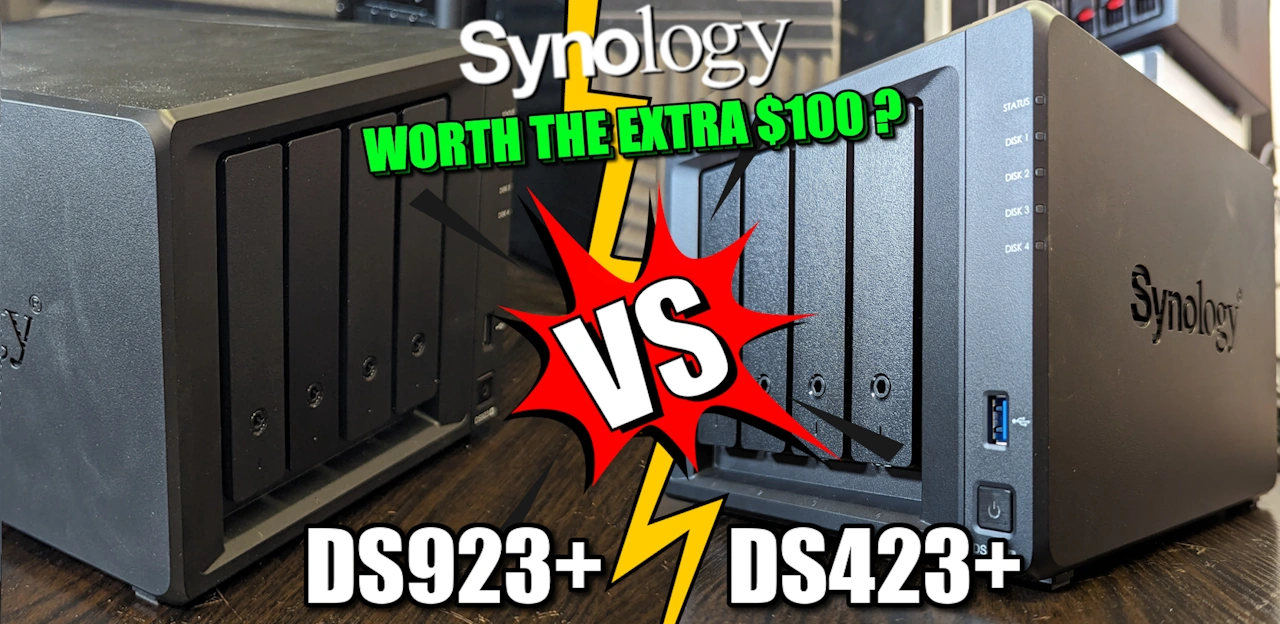
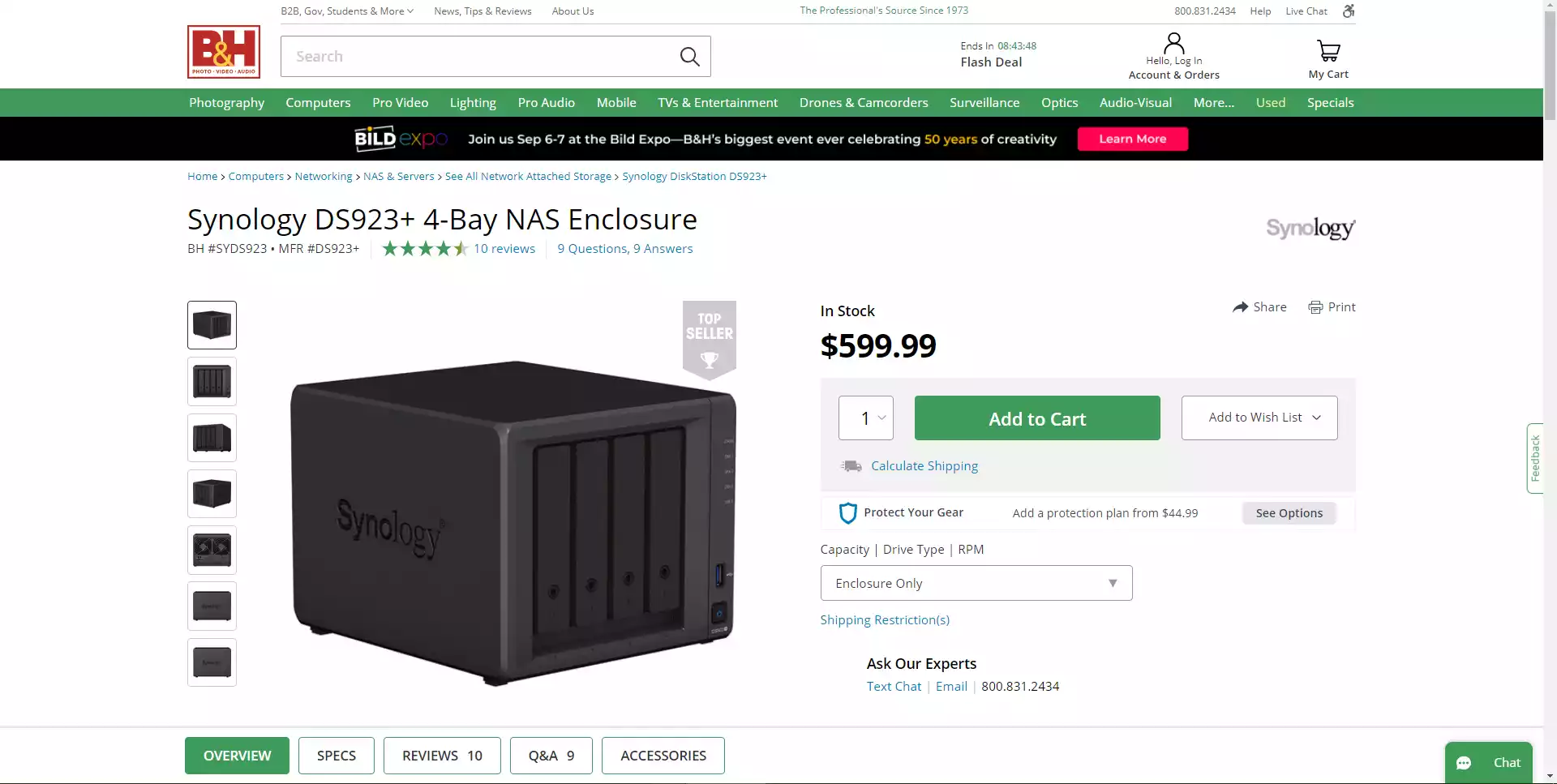


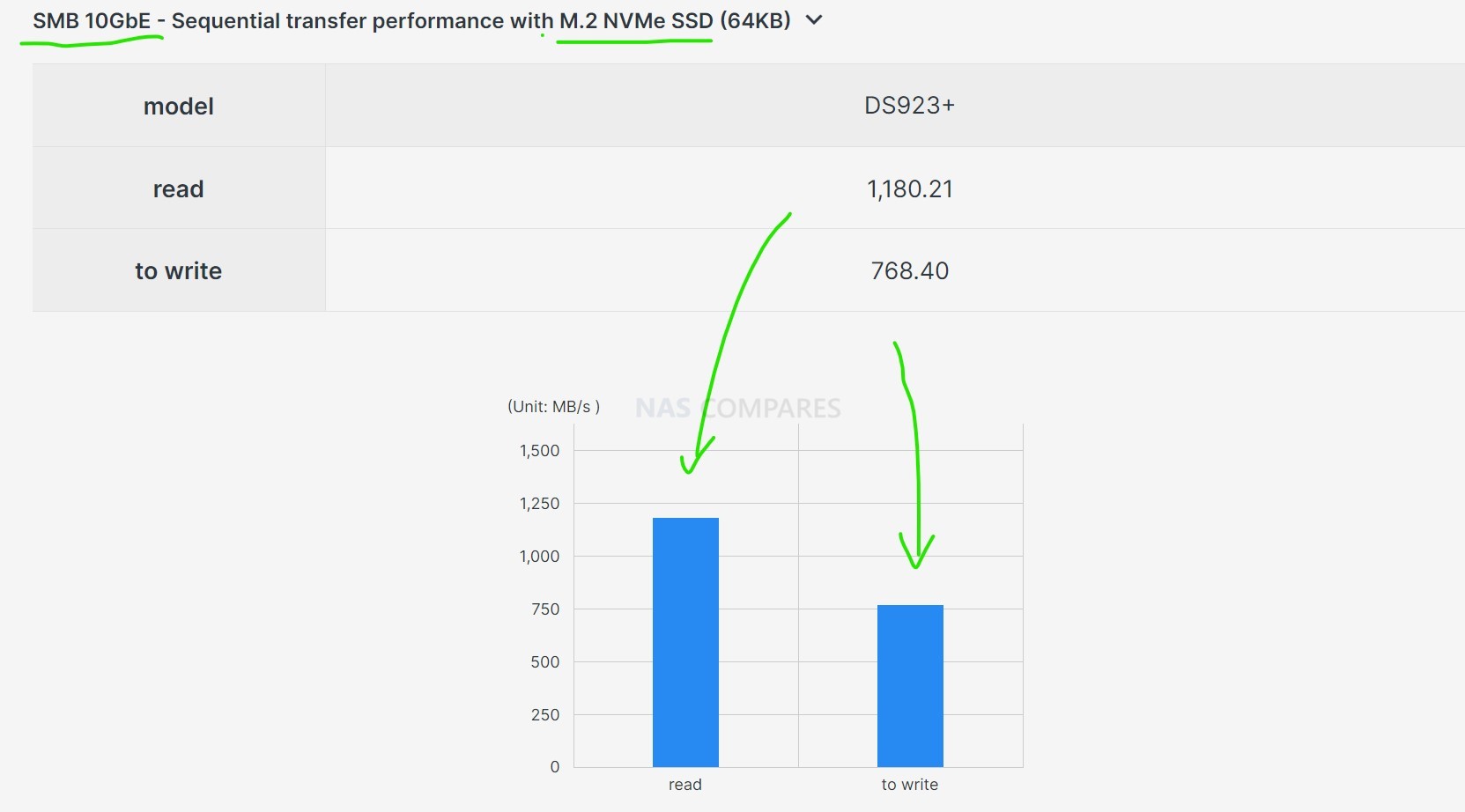
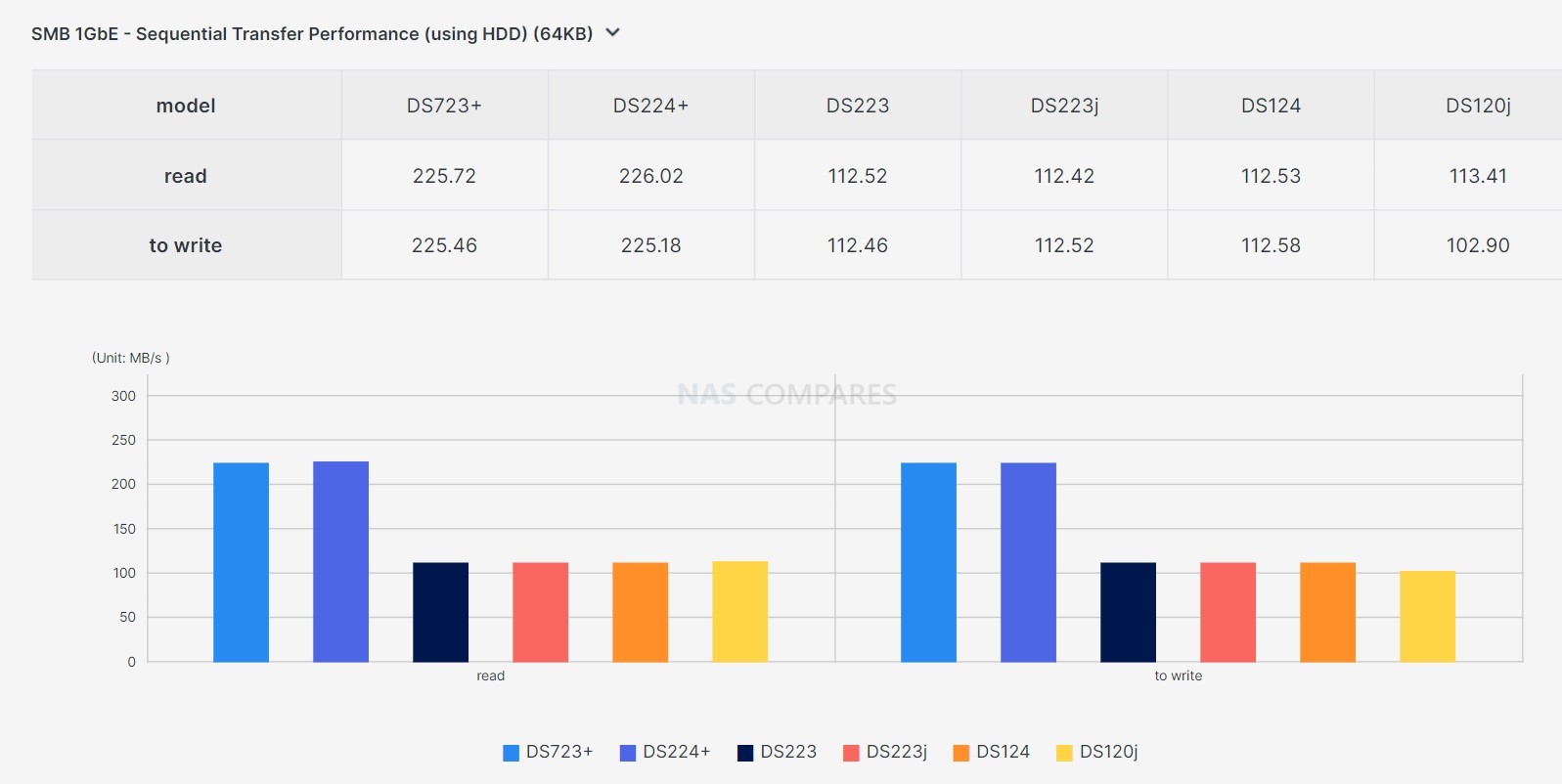
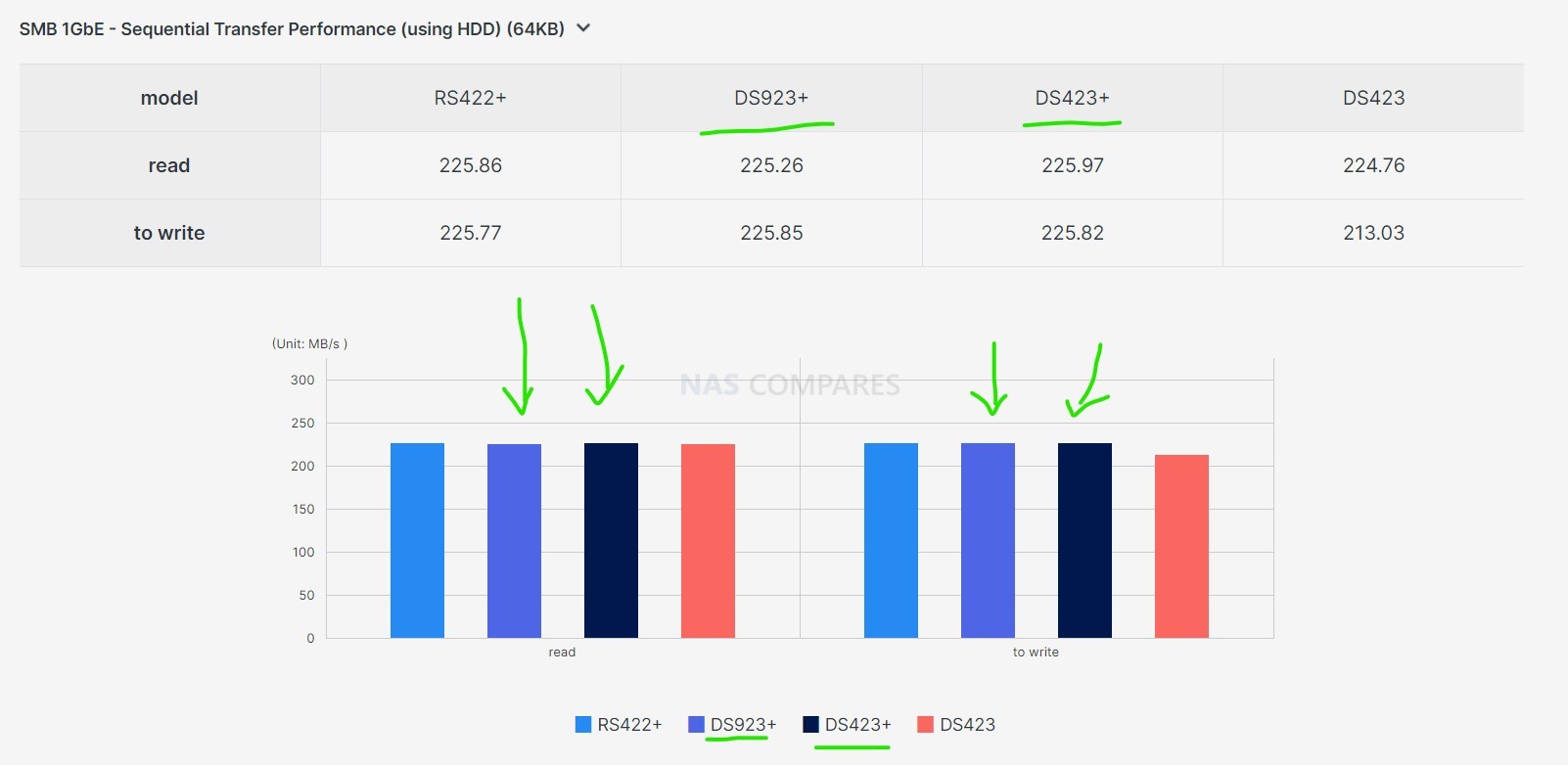


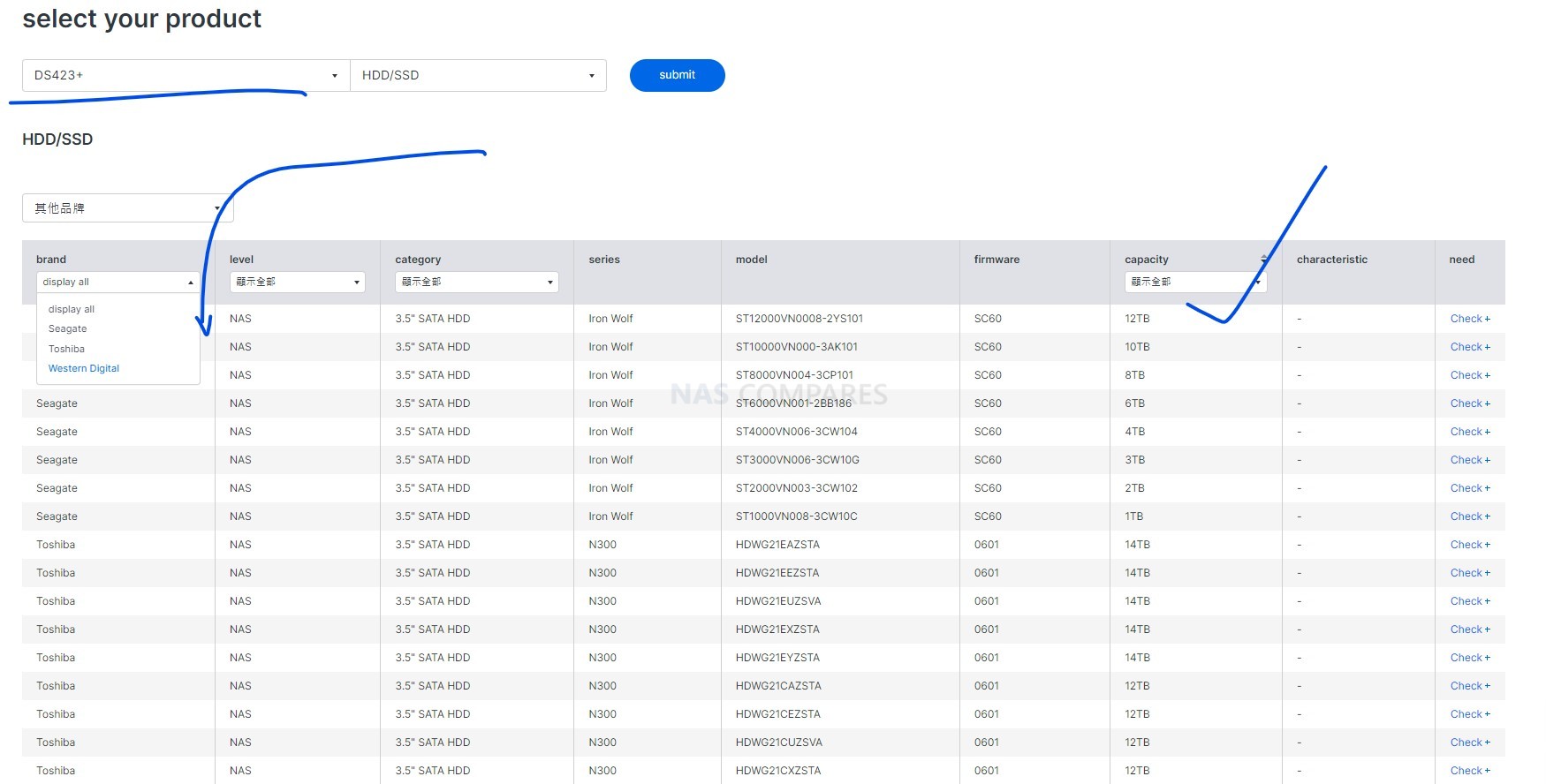
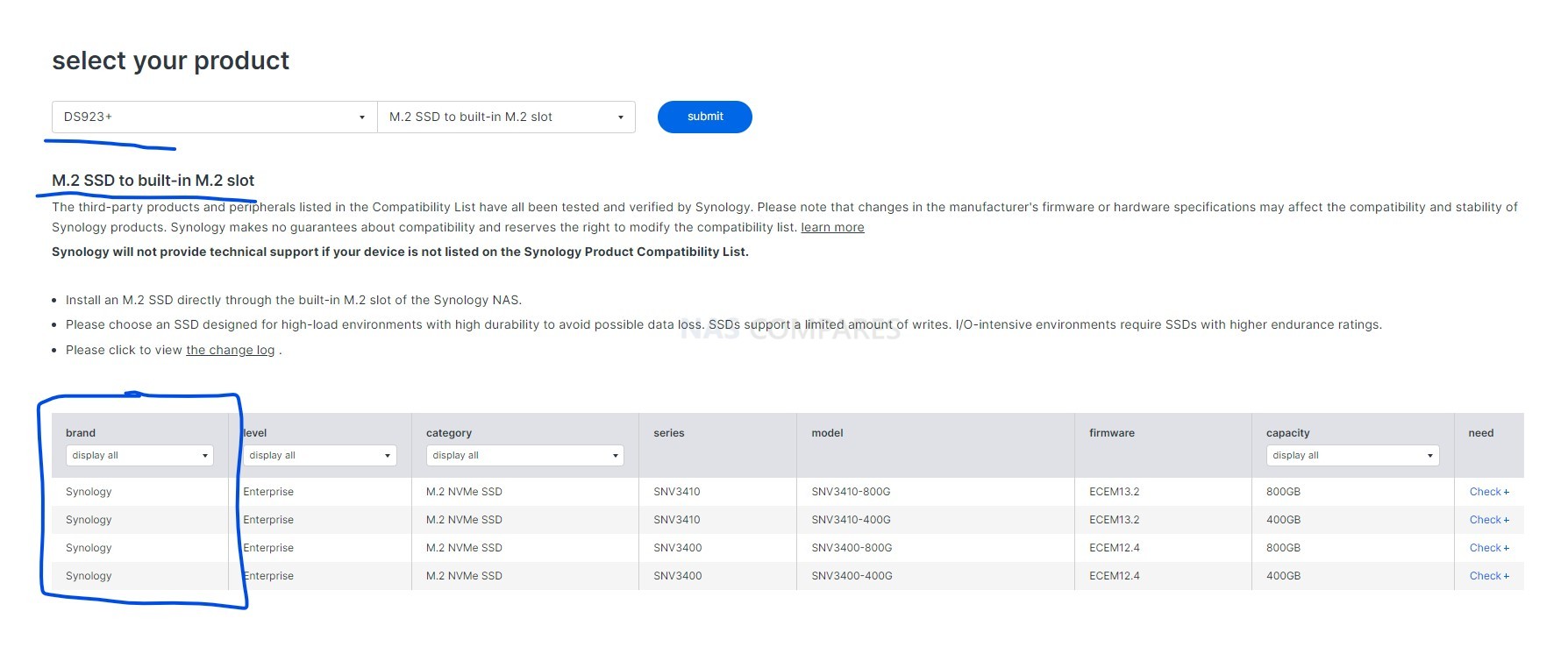




Thank you – very helpful. Just found a 920+ with 20gb ram (not offically supported but common I understand), due to your advice of having the intergrated GPU, to stream my 5.3K gopro videos. Hopefully this was the right call.
REPLY ON YOUTUBE
Note to self – onscreen order is:
DS423
DS923
DS920
REPLY ON YOUTUBE
Does synology products go on sale during sale season?
REPLY ON YOUTUBE
Thanks from France for your video, but can you show us the differences by reading a movie between this 3 NAS ? I can’t really understand what they can do or not.
REPLY ON YOUTUBE
American here, you’re talking too fast for me!
REPLY ON YOUTUBE
Im buying the DS423 next week and call me stupid but can i add any hard drive into these and obviously they work fine with OS correct? @NASCompares
REPLY ON YOUTUBE
hi, why the DS923+ is USD 944 on amazon?
REPLY ON YOUTUBE
First off I am looking at getting a 4 bay NAS, mostly because my wife and I have a lot of Photos and she uses Lightroom to work all her photos. I use DaVinci Resolve to make videos.
We both have a lot of external Drives and this is why we wanted to get into a NAS.
Even though we are not Computer Programmers we enjoy and are learning alot from you and your shows.
Do you think the DS 923+ would work better for us or should I buy the DS423?
REPLY ON YOUTUBE
Gosh, they make their drives super complex for the customer to select the right one. Why? I am looking for storage for around 1tb of photos and work files and 5tb of music, movies and home videos. I would like to stream to Plex and ideally all run from the NAS. I have had an awesome Drobo 5N but now they have gone, I am worried about losing stuff. I was about to pull the trigger on the DS423+, but now am thinking that I may have selected the wrong NAS. Is this the best out of the three for my use case? Sorry, I watched the video and am a little confused by the future proofing and upgradeability. But maybe I shouldn’t worry about this
REPLY ON YOUTUBE
Ok, so DS423+ is what’s I’ll be looking for.
REPLY ON YOUTUBE
Does the GPU on the DS423+ also come into play when indexing and viewing photos? Would this unit perform better than the DS923+ for photos?
REPLY ON YOUTUBE
Would i benefit from having the integrated graphics (ds423+) if i’m streaming to my iPhone 13 over the internet? Or would I benefit from the faster file reading of the AMD cpu? (ds923+)
Pls help! Clientside… Encode… transcode… i dont know what that is or if an iPhone can do that.
REPLY ON YOUTUBE
Really heard Intel Sauron processor 😛
REPLY ON YOUTUBE
Synology is big regret becarefull there is no good services and support !!! Bad work team…
REPLY ON YOUTUBE
Thank you for this detailed overview
REPLY ON YOUTUBE
I’ve got and use a 918+ with 4 x4Gb drives. and its full to upgrade i can get the 5 bay expansion for £470 or a new 923+ for £570 with all the advantages that gives. The expansion is so close to the price of a new nas It’s hard to go for the expansion
REPLY ON YOUTUBE
My DS920+ is running with 12GB RAM, with an additional 8GB Stick. I used it to takeover from my DS412+
REPLY ON YOUTUBE
They look exactly the same, you talk about them and point at them without saying the model number (After the intro) and now I need to try and guess which one is which… a small sticker on each one will have made this video much easier to understand. Other than that a very good comparison for users looking for a NAS.
REPLY ON YOUTUBE
Thanks for sharing, so If I understand correctly, for DS Video, the DS423+ could be a better option, specifically if I would need transcoding. I need to upgrade my aging DS 412+, the heavy lifting application running on this besides the File sharing servers, is DS Video, clients are AppleTV 1080p, Amazon Fire TV, sometimes iPads/iPhones. Everything is running fine on the DS412+ but that unit is 10 years old and should be refreshed. I think the DS423+ would be a better choice, am I correct ? Thanks !
REPLY ON YOUTUBE
Very interesting comparison! Thanks! Two comments:
1. Do I correctly assume the article’s references to a “DS723” are just typos & should be read as “DS923+”?
2. The article makes a strong point about how useful the Intel Integrated Graphics in the DS423+ can be for multimedia operations, but didn’t seem to address whether or how the AMD processor in the DS923+ makes up for the absence of Integrated Graphics for multimedia operations. Does it?
Yes, the DS723+ and DS923+ are essentially the same, differing only in their bay count.
Ryzen is a good alternative when accessing media locally. A GPU is not needed in this case, as these CPUs do not have integrated graphics chips
So I’m looking for an upgrade for my old ds 215j, and i know now a lot more about NAS since then..
But I forgot an important thing before buying it…
Research and looking for what I really wanted ????…
But today I am a bit wiser ???? and I know which choice would be better..???? then 512mb Ram and dual-core arm Processor ????
Realizing the Meaning of Slow ????
Anyway I forgot another important thing..
To get a part of your channel, due to a subscription and thumbs up ???? for your good work and videos.❤
Thx Mate and greetings from Germany
REPLY ON YOUTUBE
Honestly this vid is actually useless for some people. First of alle the prices in the EU are different. The DS 920+ is the worst with 1300€ + for only the case compared to 510€ for the DS 423+ and 600€ + for the DS 923+. The price for the DS 423+ is cheaper and it comes with slower cores but 4 instead of 2 and iGPU. For everyone that want to do more with the NAS like docker, VMs and Plex/Jellyfin Server the DS 923+ is a really bad option. The DS 423+ is the only current model that I really like. I know only 2 GB of RAM but you can buy a 16 GB RAM stick and you are running the DS 423+ with 18 GB of RAM. Correct me if I‘m wrong. But I still pissed that the hardware of from 2019/2020 from a 2023 model.
REPLY ON YOUTUBE
Does the 923+ have integrated GPU like the 423+ ?
REPLY ON YOUTUBE
Great comparison video. I have a DS920+. Thus, the DS923+ is probably my best option for a seamless fail over solution.
REPLY ON YOUTUBE
Pro Tip: Don’t say “This one” say what the model is.
REPLY ON YOUTUBE
Wow that was amazing, thanks for the vid! I really enjoyed the granular breakdowns.
REPLY ON YOUTUBE
Been running a DS216 since it came out, been perfect, no issues. Just upgraded to a DS923…love it.
REPLY ON YOUTUBE
All, just stumbled upon this video and recently purchased a 923+. I got (3) 16TB Seagate drives in RAID 5 and am considering getting a Samsung 970 Evo Plus for caching. Anyone have any input in this? I know it isn’t in the HCL, but some people said it works fine for caching? Do you need to install in pairs?? TY!
REPLY ON YOUTUBE
DS920+ was the best purchase I ever made.
REPLY ON YOUTUBE
When working primarily with Video Files, is the DS923+ a bad choice since it has no integrated Gfx?
REPLY ON YOUTUBE
Boring with talking, you’d better make some slides.
REPLY ON YOUTUBE
USB-C 2.5, 5, 10 GB adapters are supported via opensource drivers if you can follow a slightly technical reddit guide.
REPLY ON YOUTUBE
Very good Video, thank you. ????
REPLY ON YOUTUBE
Please explain, why would anyone need to transcode video? Every player, every stick or tv plays everything you throw at them, why loose quality and resources for streaming? This is for in-home use only question.
REPLY ON YOUTUBE
I bought DS423+ after comparison reviews from your channel, and watched this video while still waiting for it to arrive. Great job! Is someone at the door? it’s my NAS arrived!
REPLY ON YOUTUBE
I have been out of the loop for a couple of years and notice it’s still the same with Synology. You get a nice looking box for way too much money with everything agonizingly capped. I have 3 and I am fairly pleased with them (they do the job) but them being so cheap and scarce on EVERYTHING remains hard to swallow. I would recommend anyone considering a NAS to look further. It’s just too insulting what they’re playing hardware-wise, they’re yerking the consumer around.
REPLY ON YOUTUBE
only half the head but still the YT controls over the tech data when stopping the video to read them…
REPLY ON YOUTUBE
It would be great if in some DSM update M.2 can be used with another models, companies, not just from Synology. That is insane… just from Synology and limit of their storage. If they make some upgrade like as motherboard can use different memories…not just from synology.
REPLY ON YOUTUBE
Hi, I bought DS923 and just to say for info that everything is running great, very smooth. I made upgrade to 32GB ram, 2x4TB WD RED (personal files) , 1x 8TB RED (Plex), 1TB SSD (Business, VM, etc) and M.2 256GB cashe. I use Plex with OpenVPN and it runs very nice. Very different if you use it without OpenVPN… and If there are 4K movies in some cases, not that often, but there is a client that can handle it. At the end I am very satisfied with DS923+ from the business side (Backup, security, Snapshot, Virtual machine, etc.) and from a personal side (Photos, Plex, etc.). In the beginning I thought that I will have some problems but I organised everything how will be in use and now I am satisfied. ????
REPLY ON YOUTUBE
Why I dont recommend synology if you’re a linux user – you cant do basic things like give ssh keys for use with SCP unless you make every server_user in admin group – what idiotic snot at synology came up with that???? sure, you can use rsync and scp to their respective shares, all good – BUT – you have to run the trhings manually because some idiot decided non admin users cant ssh in – to setup keys…… or do synology think its more secure by allowing every server including remotes, to be added as an administrator!
REPLY ON YOUTUBE
Great video. How would the DS918+ compare with these? I know it’s older but the reason I’m asking is that it’s become available refurbished from Synology at a very decent looking price.
REPLY ON YOUTUBE
I have roughly 75 tb of music & videos combined (both are in the MP3 & MP4 formats) . I’ve been doing a lot of research over the past year or so. Do you have any recommendations on which model you’d recommend?
I’m interested in having it set up as….
-A RAID 5 or 6 (from my understanding, the major differences are the amount or drives that can fail at once). If my understanding is correct, then the cinfig will be RAID 6. As a better, more secure solution.
– 6 – 8 bays (with expandability) – so one of the Plus model’s
– Filled with 20 or 22 tb Seagate Drives
– I will also be maxing out the M . 2 slots with the highest expandability **STRICTLY for Caching only**
– Preferably 10 gb ports, with expandability options up to 25 or even 40 gb read speeds. Or whatever will be the fastest to stream a 1080p music video, with having the only limitations be the remote user’s connection.
I would like to set this up as a place where I can access the entire collection in all one place, similar to a media server like spotify or youtube, but just with my own content. I will also be purchasing a Plex pass.
REPLY ON YOUTUBE
jus some help, if I am only interested in running PLEX, from the presentation, the 423 sound like the better unit. Even if i am using a Samsung that the PLEX app is built into the TV. would this be correct ?
REPLY ON YOUTUBE
Had this on in the background over a couple of days. This is the comment you requested — I made it to the end! =D
It’s definitely not in the budget for me yet, but I’m dreaming about a NAS in my setup in the future!
REPLY ON YOUTUBE
Just curious how to compare the performance of different CPUs? It seems that the new version have less cores but have higher frequency. How to tell the new one is a big jump?
REPLY ON YOUTUBE
I paid $475 for the DS923+ brand new on Amazon ????
REPLY ON YOUTUBE
I’m pretty sure that 923+ is the only one that has Docker.
REPLY ON YOUTUBE
i have buffering with the 423+ in plex when transcoding 4k hdr movies with tone mapping transcoding enabled…. :/
REPLY ON YOUTUBE
Useful info, thanks. As a photographer with half a million image files, I’m currently using a DS920 with 40TB to store them securely. However, the move to 10Gb with the 923 will speed up the system when editing in Lightroom plus the memory expansion will help I’m sure. But I’m not sure whether your points concerning the lack of integrated graphics on the 923 is relevant in the case of Lightroom image storage and editing rather than the video streams case. Any info/suggestions on this?
REPLY ON YOUTUBE
I have a much older DS1019+ with 5 bays and 2 NVME slots. A couple of things are common. If you are only going to use the NVME as cache then 2x256GB NVME is big enough. I use Raid 1 on my cache. I bought 2 1TB NVME but the Synology never seems to need more than 256GB. I can have different size drives in my DS1019+ but the amount of storage is roughly equal to 4 smallest drives of the 5. In the case in the video it would be the 3 smallest drives of the 4. I like the storage pool idea that mine doesn’t have, I would probably use it because of my big 1TB NVME flashes. Being able to transcode is handy but I have a Ryzen 9 CPU and an Intel I9 with an older GTX1080. The internal AMD graphics seem to encode just a hair faster than the GTX1080. It helps to read and write to fast SSDs. I like synology software. I have their router two and the software looks and feels similar.
REPLY ON YOUTUBE
I wish there was an overlay saying which one was which, had to keep rewinding back.
REPLY ON YOUTUBE
Will all these drives take any Sata hdd?
REPLY ON YOUTUBE
Very useful – exactly what I needed. Thank you!!
REPLY ON YOUTUBE
423+, 920+ or stick to 918+ that’s my question? Hi all, I was one of those who desperately waited to upgrade to a 923+. Since transcoding is essential, I’asking myself which option to pick. DS920+ brand-new is 699€ in DE (the rest out of stock). DS423+ (520€) downsides are very good explained in the video. Both options technically are not what I expected. So wait for the DS925+ and stick to the DS918+?
REPLY ON YOUTUBE
I recently bought a DS1522+ and did not realize it had an AMD chip. Most of my 4K video also has 1080p versions. How likely is it that using devices like tablets and phones, we are going to see some lag, and should I consider looking at one of the two Celeron based units as an additional device to stream from.
REPLY ON YOUTUBE
I’m in the process of getting a new NAS. This video was very helpful to understand what to look for. Thanks!
REPLY ON YOUTUBE
Okay.. If not 920+, which one of these two? My use case is: Streaming remux mkv. to my home theater, back up, photo alnum stuff and a bit of surveillance.
Thanks in advance
REPLY ON YOUTUBE
Thanks for compare this products!
REPLY ON YOUTUBE
no hard drive, no 10gbe port , no nvme drive, ram to be upgrade, 600 dollars for a box, very soon we will be working in synology factory
REPLY ON YOUTUBE
i did watch the whole video
REPLY ON YOUTUBE
I always had fomo for buying the 923 bc of “integrated graphics” but this video makes it clear that I don’t need it. I’d rather use client side transcoding (if ever needed) and faster file transfer any day.
REPLY ON YOUTUBE
Conclusion the models x23+ are total failed for Synology. Most of the devices at home are using 1GB network, so it gives you zero improvement and need to spend more money for additional card. USELESS! CPU has only 2 real core instead of 4 real cores on the previous model, a little bit faster on single thread but it is not a home PC, again BIG FAILED! If I need to expand I will go at the beginning with bigger model with 8 disks or so, to eSATA is USELESS too. Ni IGP, so advantage of the CPU when you use it for video decoding. Conclusion, get the old model and wait next models of Synology 426+ or 926+
REPLY ON YOUTUBE
Good luck finding the 920+. I had to buy mine from Japan for almost twice it’s original release price.
REPLY ON YOUTUBE
I have the QNAP TS-1655 and want to know what is the most important upgrade to purchase? I run Plex from it now so I am wondering if I’d best get an add on GPU or upgrade the RAM? I was also wondering if a GPU has to be a certain kind or can this support any GPU installed? I just started following you. Great reviews! Thank you
REPLY ON YOUTUBE
You are a mind reader, I was struggling to understand what was the difference between these – legend.
REPLY ON YOUTUBE
I have a question wheter or not the 923+ is the NAS for me. I am also looking at the 423+ and QNAP TS-464. I shoot a lot of footage with my drone in MP4 format. So will the 923+ do the job for me if I play this on my PC or on my tablet?
REPLY ON YOUTUBE
Do drives that sit in an expansion unit perform slower than those sitting in the main unit (because of all that cabling between the units)? I.e. do expansions come with a performance hit relative to housing all your drives inside the main unit? I.e. is buying a bigger main unit up front better than counting on expanding it later (if money is not an issue)?
REPLY ON YOUTUBE
Ds920+ still kicks ass! Synology’s hardware still makes no sense.
REPLY ON YOUTUBE
Great review – BUT a wish for improvement: I don’t watch whole videos actively, I often wash dishes or don’t concentrate fully on the video while watching videos (that are not purely visual). And you always point on a NAS and say ‘this is better than this’ or ‘in this case you want this’.
Now if someone listens more to the audio – he won’t understand which one you refer to.
Saying ‘923 is better than 920’ or ‘in that case you want the 920’ – would be a sooooo much better.
Thanks and keep up the great work.????
REPLY ON YOUTUBE
Make the comparisons on graphs and show the differences in value. The waving hand is a bit boring.
REPLY ON YOUTUBE
Very helpful insights, thanks
REPLY ON YOUTUBE
I bought today a 423+ for $525 in Ukraine. Same price as the two-disk 723+. Used 720+ and 920+ are too expensive.
REPLY ON YOUTUBE
great review!
REPLY ON YOUTUBE
The AMD R1600 may have a clock speed advantage, but I wonder why they didn’t look at going with something like an embedded V1605B which has 4 cores and 8 threads as well as Vega 8 graphics for the video encode/decode while maintaining a TDB between 12-25W. It would be far superior to both the R1600 and J4125 in every way.
REPLY ON YOUTUBE
Feedback from a new person to the channel: it’s hard to listen to your video as a podcast, without visuals, because you do not always mention verbally which of 3 NAS models you are currently talking about. Like: “In terms of value for money this one is the most value, and this one comes really close”. This one — which one? 🙂 Since I mostly watch YouTube on the go during walking would appreciate if you mention the model numbers more often.
REPLY ON YOUTUBE
I bought the DS923+ and installed 32GB RAM and took a WD RED 1TB SSD for the system. The main data is stored in RAID1 on 2x WD RED Plus 14TB and an 18TB WD Ultrastar as a data grave.
Photos, Plex, Docker and VMM run great and I am very satisfied.
Thanks here for the great and informative videos. Keep up the good work.✌????
REPLY ON YOUTUBE
My 920+ is still going strong! I wouldn’t run any VMs on it, but it’s great for Docker containers.
REPLY ON YOUTUBE
Your videos are too long. You can cut it down by half and get more views
REPLY ON YOUTUBE
I need at least 400 mb/second for 4k video editing. Would be nice to not have to upgrade models (obviously), and I need around 30 terabytes of storage, probably more in the future. Should I go for a 4 bay or 5 bay?
REPLY ON YOUTUBE
If you have seedbox and connect with ftp client on synology can remote from your phone if you not are home ?
REPLY ON YOUTUBE
Thank you Robbie. I have had a DS 920+ for about a year. Cracking machine.
REPLY ON YOUTUBE
I think about the ds423+
Two questions:
1. Is it possible to use any (kind of) nvme ssd for volumes? Or only on synology nvmes?
2. Can you make a test about how much mem i can really install? Usually in this cases it is possible to add some extra memory like 8GB instead of 4GB. What do you think?
Thanks. Great video like always
REPLY ON YOUTUBE
Thanks!
REPLY ON YOUTUBE
Could you guys at NAS compares do a video about what hardware you would put inside a 4-bay Synology NAS (let’s say a 924+) if you could design one?
REPLY ON YOUTUBE
DS423+ soldered RAM 2GB, no thanks.
REPLY ON YOUTUBE
Good and interesting review.
I have a DS1821+ with 32Gb RAM, 10Gb board, running DSM-7.1, and I am very satisfied.
I may be wrong, but the problem with our review when you talk about the possibility to create a Storage Pool on NVMe drives, is that you must buy the very expensive Synology branded NVMe sticks !!
Unless I have been told something wrong, you can’t use third party NVMe sticks, and this is a VERY bad news !
I am not going to pay the huge extra cost just to get a synology sticker on the NVMe drives, so unless somebody finds a hack, I will look to another brand, just because of this problem artificially created by Synology… and I would prefer to stay with Synology (so hackers are welcome !)
REPLY ON YOUTUBE
Here’s a talking head video idea,
Whats Sinology’s history with how long DSM support extends, and when will update support end?
Is there a year, or an age, or level of NAS that will not be able to receive DSM 7.2, as support will have timed out?
Personally I am running a 918+. Even though I am not worried at all about this 7.2 update or any update soon after that from being able to be updated on my NAS … when can I assume I will be unable to install an update? What’s Synology’s history here.
And is there a difference between software update support timelines and security update timelines … like Windows, which will stop updating and supporting certain Windows versions, but will still throw security updates at us for a few years. Is Synology been operating like that?
And finally, obviously a running personal home based file server and Plex NAS does not need the same level of ongoing critical security updates that a Windows Operating System needs to remain safe … that said, is it actually problematic to run a home NAS like this (obviously not an enterprise or security conscious business use) beyond the time of manufacturer security update death? Can I literally run this thing for years, even using occasional online file access, when we are out?
And as an extension; do other NAS manufacturers have different approaches to this issue?
REPLY ON YOUTUBE
I’ve been shopping to replace my ancient DS413j. I use my NAS for home file storage and media streaming. Until now I’ve been keeping my PC on 24/7 running streaming software with my NAS just as a storage device. I’ve been wanting to run the streaming app on my NAS. I bit the bullet last month and purchased the discontinued DS920+ even though I had to pay $150 USD over MSRP for it. I think I made the right choice as it best meets my present needs. I like some of the future proofing features of the DS923+ but it is less capable for what I want to do today. NASCompares has been very helpful in my decision making.
REPLY ON YOUTUBE
Yeap, the 923+ is the NAS for me to upgrade to. I can use my current 8TB drives in my DS216j when I move to the 923+. Adding in 2 18TB or higher drives will give me the added storage I need before adding a NVME drive for a storage pool. I may just use one for storage and the other for writes to the hard drives. $600 to start seems fair in these turbulent times. I am saving up for this one, unless they release a 5 bay version, lol. Thanks for this!
REPLY ON YOUTUBE
are WD Red Pro HDD compatibility on DS923+?
REPLY ON YOUTUBE
Is it possible to install on DS423+/DS920+ memory ECC? Thanks
REPLY ON YOUTUBE
Great comparison! Thank you ????
REPLY ON YOUTUBE
Was so mad when I bought a DS918+ in March 2020 only for the 920+ to come out four months later. Now I’m glad I have the 918+ because I can almost justify upgrading to a 923+ now.
REPLY ON YOUTUBE
So can we conclude that given the fact that the value of the 920+ is really close to that of the 923+ Synology has accomplished next to nothing in three years time in terms of hardware? Are they already on the path of saying goodbye to their NAS-boxes to focus solely on future versions of DSM?
REPLY ON YOUTUBE
2-core “upgrade” of the 923 is a joke, and claiming it’s “enterprise” focused is outright laughable. The benchmarks are pretty clear too, the R1600 is ≈5% faster, because of single core performance alone, which is honestly counterproductive compared to what you’d want in server/NAS environment, running multiple processes. And ofc as you’d expect it’s gets completely slaughtered by the J4125 in multi-core performance.
REPLY ON YOUTUBE
I got a 1522+ last month. Chose it over the 923+ because it was only $100 more and it has 8GB memory instead of 4GB and has 5 bays vs 4 bays.
I have been very happy with it and use it for storage, backups, Plex and much more! Very happy with it.
I use all 4 1gbe connections in LAG setup. Another plus, compared to the 2 connections on the 923+
Don’t have to worry about multiple computer file transfers and Plex clients slowing transfers down when they are all happening at the same time.
REPLY ON YOUTUBE
In the light of synology`s poor hardware “upgrades” for 2023 variants, then I have kept my good old 1520+ to serve the needed apps as cloud and survaillance station etc. It has been left to mind its own business in a corner… -And then I build an UNRAID server with an intel 12700 on a board with a 2.5 Gbit nic…. thats gives much better options as a combo than upgrading to a newer synology!
REPLY ON YOUTUBE
I’m so glad I got a 920+ while they were available and a reasonable price still. I don’t think the 923 is much of an improvement really and the 423 is IMHO way over priced.
REPLY ON YOUTUBE
Wow, just what we need a comparison of the top Synology drives for home or SMB use. Thanks for this.
REPLY ON YOUTUBE
Hi, love your work. Can you do a video doing an extension to add 5 more disks. I wish i could find that prices. I’m from Portugal and the lowest price i found was 600€. Any advice were to buy cheap? thanks for you job. Best regards.
REPLY ON YOUTUBE
How faster AMD CPU can run 4K Plex video ?
REPLY ON YOUTUBE
Some of the sites you show as having stock for the 920+ are not legitimate websites. If you’re a buyer please look them up on trusted review sites first.
REPLY ON YOUTUBE
You are too kind. The move from Intel for the 923+ means it is still borne for me. The 920+ is simply fantastic and great value for money. The 423+ is a bet meh as well. And for more money than the 920+. Fortunately I am not likely in the market for another NAS for a good while. I hope Synology sales reflect this and they realise the consumer market should be given a decent option without having to buy into am enterprise level system.
REPLY ON YOUTUBE
Not gonna touch the 923 with a 10ft pole. No graphics = DoA.
REPLY ON YOUTUBE
Ive’ been on the fence with adding a Synology to my collection.
I guess I never new about the trans-coding with integrated video for streaming directly from the NAS and that helped a lot.
Thanks for the in depth review. I’ve been a very long time fan of the channel and appreciate your efforts.
REPLY ON YOUTUBE
when do you think Synology will start using the new AMD processors with intergrated onboard graphics
REPLY ON YOUTUBE
Synology is going backwards for media server users. Shame
REPLY ON YOUTUBE
Thanks, I’m thinking about buying 4 bay NAS.
REPLY ON YOUTUBE
Thanks for another useful video. Have you considered doing any pieces on longevity or technical issues over time? I’ve been running a QNAP TVS-472XT since 2019 without issue but yesterday it bricked itself during a firmware update restart – I now believe due to a bad motherboard just waiting for the next restart before it would refuse to power up again. A quick search reveals a 58 page thread on the QNAP forum about this issue which seems to affect lots of TVS-x72XT units, 4, 6 and 8 bay versions. I also believe QNAP have recognised the issue in some regions, extending the warranties, and replacing units. I’m just starting the official process, but like many in this position are wondering about long-term reliability and also how easy it will be to pop the drives into another enclosure to regain access to the array. I could try an identical unit, but it’s an expensive replacement and I no longer trust that model. It would be interesting to see how widespread this issue is for this model, as it was well reviewed by many, including myself at the time. As an aside, the TB connectivity which I chose it for also stopped working on my Mac after either an Apple or QNAP update a while ago, so that feature is moot too. Shame as it was a really nice unit when I first started using it.
REPLY ON YOUTUBE
No integrated graphics / 2 core CPU = poor value for money
REPLY ON YOUTUBE
I would probably have to get the 1522+. Would also need 10 gbe.
REPLY ON YOUTUBE
Great content! Thanks for your time and experience!
REPLY ON YOUTUBE
I’ve seen reports of using the read-write cache option causing the entire raid volume to crash if an ssd fails, so I’m personally going to be sticking with the read cache only.
REPLY ON YOUTUBE
How this doesn’t have more likes is unjust. He covers so much and shows great examples. He also has time marks for reference. Great resource! Keep up the good work, would give you more likes if I could.
REPLY ON YOUTUBE
One thing I wish sonology would do especially further backup program is allow you to back up to a networked windows pool drive aka the NAS sync with networked multipooled Windows drive giving you to a form of backup even if you cannot see the data on the Windows pool that be fine if it was just an encrypted image or better yet allow the damn system to read Windows pool drives…. You’re plugging a USB hub with all your USB drives the nas makes its own virtual pool out of those drives and then it backs up just in case there’s nobody has a single 60 terabyte drive …. The fact that most people are coming from multiple hard drives externally to Nas and can’t use those multiple drives as a single pool backup is annoying especially when there’s hard drive crashes or or anything like that at least you’d have a personal backup I didn’t even pay 10-15 dollars per drive one time fee to make a pool for image backup
I literally had to Jerry rig using always-sync to back up the entire NAS drive on a 9 hard drive pool on the Windows side
REPLY ON YOUTUBE
Insert the biggest thing I hate about Synology outside of their “hard drive requirements” (if the damn hard drive says Nas supported then it should just work you shouldn’t need a specific hard drive) is them telling you where to put your media or files for specific programs they own you should be able to tell the programs just like in Plex where the files are where you wanting to put the files and have one way think as an option with no deletion
REPLY ON YOUTUBE
I personally find it difficult still for a novice user especially for making user accounts … Aka having public and private folders for individuals in a group setting (you can’t have both) we’re in the group setting everyone has the rules AKA right and no delete for public folder and the ability for only individual users in that group to only see their private folder and not everyone else’s
Aka private “Jon” public “all” private “Sarah”
John can still see Sarah’s folder
Because I haven’t nested in an outside folder public and an outside folder private where all their names are in the private folder so it’s nice and organized
But everyone can still see everyone’s folder I’d love to have it so that you can easily isolate nested folders
REPLY ON YOUTUBE
One application they should make is a network photo slideshow screen saver picture frame app with dslp and outside network
REPLY ON YOUTUBE
The one and only thing I don’t like about Synology multimedia apps or drive apps…. Is they TELL you where to put your media AND GENERALLY HAVE TWO-WAY SINK AS DEFAULT
Most users are going to have a plexa library that they’ve probably customized and should customize in one bulk “media folder” and then break it down within…. If you do stuff like that for all your multimedia they’re native apps don’t work you have to have it where they want it…. Same with sync you have to have it where they want it and it’s only sync … Me personally I want one-way sink data goes on the NAS … You can delete it off the phone or computer and that won’t transfer over…. They have improved the drive application but I still have to improve video photo and the other ones to be one way and for us to control the locations multiple or single nested location I don’t want to be told or you got to have it in the ” home /user /names/ photo/ to have the photo application work
NO I want to have it in plex media / photos/ cell phone 01/
REPLY ON YOUTUBE
why do I need raid 1 on the ssd cache? It doesn’t matter if the data is gone on the cache if one ssd fails. The data is stored on the HDD after a Data is altered in the read/write cache. or is written again from the HDD when a new SSD is added. So that makes no sense. Raid 0 would be better in this case.
REPLY ON YOUTUBE
Thank you for this Video!
REPLY ON YOUTUBE
Funny how that Security Advisor isn’t barking at you for having the standard 5000 and 5001 ports in use. Mine’s been yelling at me 24/7 about it.
REPLY ON YOUTUBE
That really is an in-depth and thorough review. I’ve had the DS1621+ for about a year and you’ve helped explain what some of the apps actually do. Thank you.
As a photographer using Lightroom to manage my my photos, I still cannot understand why I need Synology Photos or S Video to manage them?
REPLY ON YOUTUBE
Thank you for the detailed review. I am interestedin buying a new Synology Nas (920+) and i own an old XP 32 bit PC do you think there will be any issues about compatibility from Win XP 32 bit to the DSM 7.1 Synology NAs, in that case does any workaround exist?
REPLY ON YOUTUBE
I’m the one who watched the whole thing! And some bits twice. Very helpful in trying to decide between a Synology DS923+ and Qnap TS464. Synology seems to have the upper hand software-wise which I suspect carries more weight for a home user than the superior hardware of the Qnap? Thank you for providing this extensive review!
REPLY ON YOUTUBE
Awsome information. Now please a similar video on Qnap. I cant make up my mind as I need both photo management and video surveillance. It seems like Qnap and Synology takes 1 point each.
REPLY ON YOUTUBE
Jellyfin?!!! Most channels that review media server software, either only deep-dive their preferred offering, or only give an overview compression of the field. If someone like you, who can give the same enthusiasm creating two videos deep-diving two NASs that only differ by a drive bay, puts that into a spin-off series on a topic that is close to a large chunk of your demographic, that would be a real treat.
REPLY ON YOUTUBE
Thks & I just watched it again & most excellent;
I’m a retired physicist & have no real problem understanding the infinite details.
However my problem is how to keep it simple & stupid (ex: high tier levels of simplicity, brevity, encapsulation, etc).
Oh with my goal is to sociably knit-together all my family, relatives, friends, etc on my synology NAS.
Unfortunately I’m going to be Mr Tech support for them. Sooooo I gots-tos keep-it-simple is an understatement & I will be abused (I says anything for family/friends though ;).
REPLY ON YOUTUBE
I’m also only seeing 360. Can’t make out any screen. text
REPLY ON YOUTUBE
You’re a DSM PhD;
I never hear so dense of a presentation of great DSM info & my head is still spinning, thks.
Next-time, you think about having something good to drink every-once in a-while.
REPLY ON YOUTUBE
47:05 Where, When
REPLY ON YOUTUBE
Still only 360p for me
REPLY ON YOUTUBE
Still just in 360p
Hope it will fix soon.
Thx for all the effort!
REPLY ON YOUTUBE
Watched you video from begin to end! Loved the deep dive into DSM, since I am looking into buying a new Synology. Keep up your amazing videos!
REPLY ON YOUTUBE
Nice video. Does anyone know why my USB printer doesn’t work anymore on my Nas Synology ?
REPLY ON YOUTUBE
Thanks for a great video. Really explains what everything is. Recently got my NAS and been already updating hard drives in it. It will mainly be used as a PLEX Server but already considering what i will do when i start upgrading the smaller drives in it. May consider another NAS and use it as strict data back up and maybe a synology Drive / synology Calendar and Email setup. Move my calendar off Google’s stuff. We will see If i do that at some point. Great job again
REPLY ON YOUTUBE
Thank you for all the work you put into this. Very helpful.
REPLY ON YOUTUBE
My English man!!! What a video! Greetings from Greece! I really appreciate your hard work and that content. I have a DS 1520 + and I am not regretting getting it although the new 1522 is out. You have my admiration. Keep up the professional and good work.
REPLY ON YOUTUBE
Why only 360p is showing ????
REPLY ON YOUTUBE
Would it be too much to expect something similar for QTS?
REPLY ON YOUTUBE
Why 360p? Can’t see it clearly.
REPLY ON YOUTUBE
Wow ! What an episode – a full tutorial for everything ! A one stop shop – Thanx Robbie ‘ol mate !
REPLY ON YOUTUBE
Yes was wondering why its. 360p till saw the comments
REPLY ON YOUTUBE
*Note* – Regarding picture quality, this is a BIG video (so many features to cover in a single video) and YouTue can sometimes be a little slow to process HD and 4K uploads, so if this video is in low-quality for you, maybe come back in an hour or so, as YouTube should have finished processing it and have the 4K, 1080p and 720p versions done. Thanks for watching and hope you enjoy the review of Synology DSM 7.1, featuring the DS923+ NAS.
REPLY ON YOUTUBE